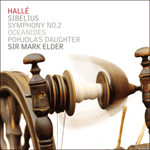The tone poem
The Oceanides (‘Ocean Nymphs’) was composed in 1914 to a commission from two wealthy American patrons, for performance at the Music Festival in Norfolk, Connecticut. By the end of March Sibelius was able to send the score to America, but soon he was working on a radically new version of the score—effectively a new composition on some of the old themes. Some of the revision was actually done during, and after, the long sea voyage. Did Sibelius’s first experience of a vast ocean affect the character of the music? It’s tempting to think so. As the Sibelius conductor Osmo Vänskä aptly puts it, the first version ‘is more like a large lake than a mighty ocean’. In the revised version, the evocation of complex cross-currents, of the play of light on waves and through depths, and the sense of awe-inspiring power at the climax, are all quite new. And the experience of recreating these in music certainly left its mark on Sibelius’s next major work, the Fifth Symphony (1914-19).
from notes by Stephen Johnson © 2016
Le poème symphonique
Les Océanides (les «nymphes de l’océan») naquit en 1914 de la commande de deux riches mécènes américains, pour être joué au festival de musique de Norfolk, dans le Connecticut. Dès la fin du mois de mars, Sibelius fut en mesure d’envoyer la partition aux Etats-Unis; mais il se mit très rapidement à une nouvelle version radicalement différente de l’œuvre—il s’agissait en fait d’une composition nouvelle reprenant certains des anciens thèmes. Une partie du travail de révision fut réalisée au cours de la longue traversée en bateau, et juste après. La première expérience que fit Sibelius du vaste océan affecta-t-il le caractère de la musique? Il est tentant de le penser. Comme le fait justement remarquer le chef Osmo Vänskä, spécialiste de Sibelius, la première version «ressemble à un grand lac plus qu’à un puissant océan». Dans la version révisée, l’évocation des complexes courants contraires, celle des jeux de lumière sur les vagues et à travers les profondeurs, et la puissance impressionnante dégagée par le sommet d’intensité sont d’une totale nouveauté. Et l’expérience de leur traduction musicale a sans aucun doute laissé son empreinte sur le chef-d’œuvre suivant de Sibelius, la Cinquième Symphonie (1914-1919).
extrait des notes rédigées par Stephen Johnson © 2016
Français: Claire Delamarche
Die Tondichtung
Aallottaret [Die Okeaniden] wurde 1914 als Auftragswerk für zwei reiche amerikanische Förderer zur Aufführung bei einem Musikfestival in Norfolk, Connecticut komponiert. Ende März konnte Sibelius die Partitur nach Amerika schicken, doch schon bald arbeitete er an einer radikal neuen Fassung der Partitur—im Grunde eine neue Komposition über ein paar ältere Themen. Einige Eingriffe wurden tatsächlich während und nach der langen Seereise vorgenommen. Hat Sibelius’ erste Erfahrung eines riesigen Ozeans den Charakter der Musik beeinflusst? Man ist versucht, dass zu glauben. Wie der Sibelius-Dirigent Osmo Vänska das so schon ausdrückte, gleicht die erste Fassung „eher einem großen See als einem mächtigen Ozean“. In der hier eingespielten überarbeiteten Fassung sind die Beschwörung komplexer Gegenströmungen, das Lichterspiel auf den Wellen und durch die Tiefen sowie das Gefühl atemberaubender Kraft auf dem Höhepunkt ziemlich neu. Die Auseinandersetzung bei der musikalischen Wiedergabe dieser Eindrücke hinterließ mit Sicherheit ihre Spuren in Sibelius’ nächstem großem Werk, der 5. Sinfonie (1914-19).
aus dem Begleittext von Stephen Johnson © 2016
Deutsch: Elke Hockings


 Sibelius: Symphony No 2, The Oceanides & Pohjola's Daughter
Sibelius: Symphony No 2, The Oceanides & Pohjola's Daughter The Guardian» More
The Guardian» More
